Wenn wir versuchen, uns bei unseren eigenen WordPress-Websites anzumelden, kommt es immer wieder vor, dass die Anmeldeseite aktualisiert und umgeleitet wird, so dass wir nicht auf den WordPress-Administrationsbereich zugreifen können.
Wenn Sie dieses Problem haben, sind Sie nicht allein. Das Problem des Aktualisierens und Weiterleitens der WordPress-Anmeldeseite ist weit verbreitet und frustriert viele WordPress-Site-Besitzer. Dennoch haben wir mehrere bewährte Methoden zur Lösung des Problems getestet.
In dieser umfassenden Anleitung zeigen wir Ihnen, wie Sie das Problem mit der Aktualisierung und Weiterleitung der WordPress-Anmeldeseite beheben können. Tauchen wir ein und bringen Sie zurück in Ihr WordPress-Dashboard, damit Sie die Kontrolle über Ihre Website zurückgewinnen können!
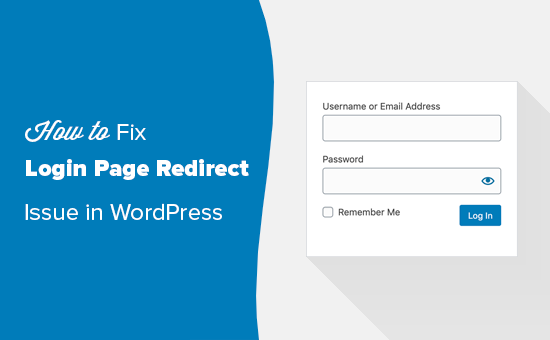
Was verursacht die Login-Seite aktualisieren und Redirect Problem in WordPress?
Der Fehler beim Aktualisieren der WordPress-Anmeldeseite und bei der Weiterleitung (auch WordPress-Login-Weiterleitungsschleife genannt) wird in der Regel durch falsche WordPress-URL-Einstellungen oder das Versäumnis, Login-Cookies zu setzen, verursacht.
Wenn Sie sich anmelden, überprüft WordPress normalerweise Ihren Benutzernamen und Ihr Passwort und setzt dann ein Anmelde-Cookie in Ihrem Browser. Danach leitet es Sie zum WordPress-Dashboard weiter.
Wenn WordPress das Login-Cookie nicht korrekt setzt oder die URL des WordPress-Administrationsbereichs nicht korrekt ist, werden Sie zurück zum Login-Bildschirm anstatt zum Admin-Dashboard geleitet.
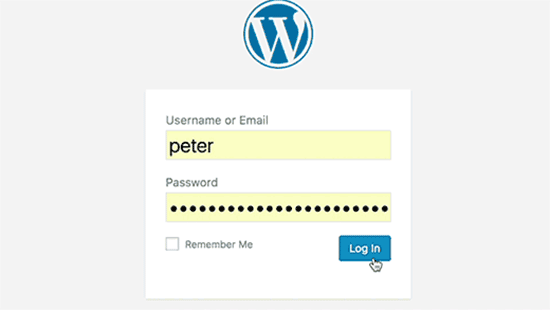
Login-Probleme können auch durch verschiedene WordPress-Fehler verursacht werden, wie z. B. den Fehler beim Aufbau der Datenbankverbindung, einen internen Serverfehler oder den weißen Bildschirm des Todes.
In diesem Sinne, lassen Sie uns das Problem der Umleitung und Aktualisierung der WordPress-Anmeldeseite suchen und beheben. Sie können diese schnellen Links verwenden, um zu einer bestimmten Methode zu springen:
- Method 1: Clear Cookies to Resolve Login Issues
- Method 2: Update WordPress URL Settings
- Method 3: Delete .htaccess File in WordPress
- Method 4: Deactivate Your Plugins
- Method 5: Revert Back to the Default Theme
- Method 6: Reinstall WordPress Core
- Video Tutorial
- What to Do If You Can't Fix WordPress Login Redirect Issue
Hinweis: Wenn Sie die fortgeschrittenen Schritte in diesem WordPress-Tutorial ausprobieren möchten, erstellen Sie bitte zunächst ein Backup Ihrer Website. Siehe unsere Anleitung zur manuellen Erstellung eines WordPress-Datenbank-Backups.
Methode 1: Cookies löschen, um Login-Probleme zu beheben
WordPress verwendet Cookies für die Anmeldeauthentifizierung. Daher ist der erste Schritt bei der Behebung von Problemen mit der WordPress-Anmeldung der einfachste. Sie müssen die Cookies und den Cache Ihres Browsers löschen.
Klicken Sie in Google Chrome einfach auf das Menü „Browsereinstellungen“ und wählen Sie dann „Weitere Tools“ „Browserdaten löschen„.
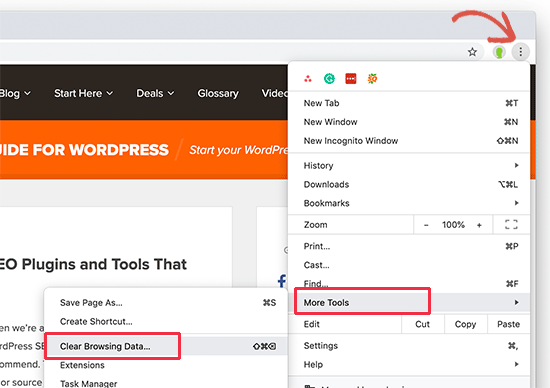
Dadurch wird die Chrome-Einstellungsseite mit einem Popup-Fenster „Browsing-Daten löschen“ auf dem Bildschirm angezeigt.
Hier müssen Sie die Optionen „Cookies und andere Websitedaten löschen“ und „Bilder und Dateien im Cache“ auswählen.
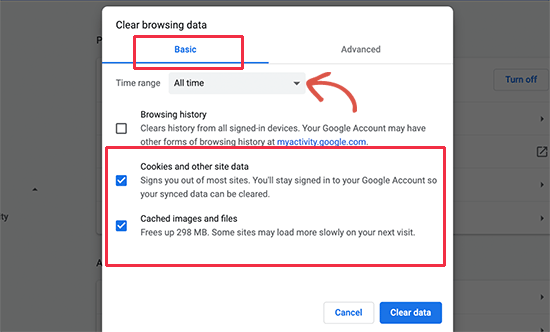
Klicken Sie anschließend auf die Schaltfläche „Daten löschen“, damit Google Chrome den Browser-Cache löscht.
Stellen Sie außerdem sicher, dass in Ihrem Browser Cookies aktiviert sind. Starten Sie danach Ihren Browser neu und versuchen Sie dann, sich anzumelden. Damit sollte das Problem für die meisten Leute behoben sein.
Wir haben eine vollständige Anleitung mit Screenshots, die zeigt, wie man den Cache und die Cookies in allen gängigen Browsern löscht.
Methode 2: WordPress-URL-Einstellungen aktualisieren
WordPress wird mit Einstellungen für die URL Ihrer Website und die URL Ihrer WordPress-Installation geliefert.
Wenn Sie Zugang zu Ihrem WordPress-Administrationsbereich hatten, konnten Sie diese Option auf der Seite Einstellungen “ Allgemein sehen.
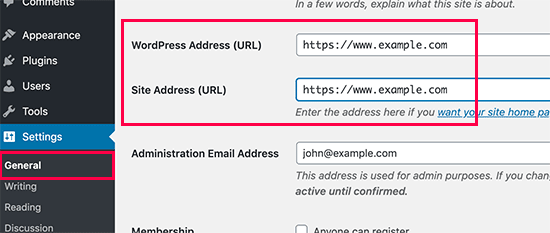
Wenn diese URLs nicht korrekt sind, leitet WordPress Sie zurück auf die Anmeldeseite um.
Da Sie keinen Zugriff auf den WordPress-Administrationsbereich haben, müssen Sie die Datei wp-config.php bearbeiten, um dieses Problem zu beheben.
Die Datei wp-config.php ist eine spezielle Datei in WordPress, die Ihre wichtigen WordPress-Einstellungen enthält. Sie können mit einem FTP-Client oder über die Dateimanager-App in Ihrem WordPress-Hosting-Konto-Dashboard darauf zugreifen.
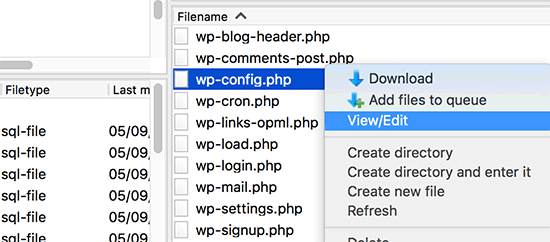
Sie finden die Datei wp-config.php im Stammverzeichnis Ihrer Website. Bearbeiten Sie einfach die Datei und fügen Sie die folgenden Codezeilen ein, direkt vor der Zeile "That's all, stop editing! Viel Spaß beim Veröffentlichen".
define('WP_HOME','https://www.example.com');
define('WP_SITEURL','https://www.example.com');
Vergessen Sie nicht, „example.com“ durch Ihren eigenen Domänennamen zu ersetzen.
Danach speichern Sie Ihre Änderungen und laden die Datei wieder auf Ihre Website hoch.
Sie können nun Ihre WordPress-Website besuchen und versuchen, sich anzumelden. Hoffentlich ist das Problem damit für Sie behoben. Sollte dies nicht der Fall sein, lesen Sie weiter, um weitere Schritte zur Fehlerbehebung zu erfahren.
Methode 3: Löschen der .htaccess-Datei in WordPress
Manchmal kann die .htaccess-Datei beschädigt werden, was zu internen Serverfehlern oder einem Fehler bei der Aktualisierung der Anmeldeseite führen kann.
Greifen Sie einfach mit einem FTP-Client oder über die Dateimanager-App im Dashboard Ihres Hosting-Providers auf Ihre Website zu.
Sobald die Verbindung hergestellt ist, suchen Sie die .htaccess-Datei im Stammverzeichnis Ihrer Website und laden Sie sie als Sicherungskopie auf Ihren Computer herunter.
Wenn Sie Ihre .htaccess-Datei nicht finden können, kann Ihnen dieser Leitfaden helfen , warum Ihre .htaccess-Datei fehlen könnte.
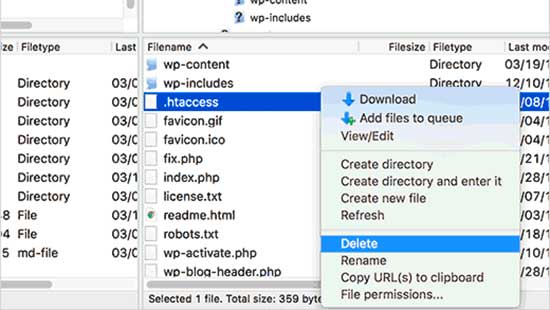
Danach löschen Sie die .htaccess-Datei von Ihrer Website.
Öffnen Sie als Nächstes das wp-admin-Verzeichnis, und wenn sich dort eine .htaccess-Datei befindet, löschen Sie auch diese.
Sie können nun versuchen, sich bei Ihrer WordPress-Website anzumelden. Wenn Sie Erfolg haben, bedeutet dies, dass Ihre .htaccess-Datei Sie daran gehindert hat, sich bei WordPress anzumelden.
Sobald Sie eingeloggt sind, gehen Sie einfach auf die Seite Einstellungen “ Permalinks im WordPress-Administrationsbereich und klicken Sie auf die Schaltfläche „Speichern“, ohne Änderungen vorzunehmen. Dadurch wird eine neue .htaccess-Datei für Ihre Website erstellt.
Methode 4: Deaktivieren Sie Ihre Plugins
Manchmal können WordPress-Plugins dieses Problem verursachen, insbesondere wenn es einen Konflikt zwischen zwei Plugins gibt.
Um alle Ihre WordPress-Plugins zu deaktivieren, verbinden Sie sich mit einem FTP-Client oder über die Dateimanager-App in Ihrem Webhosting-Konto-Dashboard mit Ihrer Website.
Sobald Sie verbunden sind, gehen Sie zum Verzeichnis /wp-content/. Darin finden Sie einen Ordner namens „plugins“. Hier installiert WordPress alle Ihre Plugins.
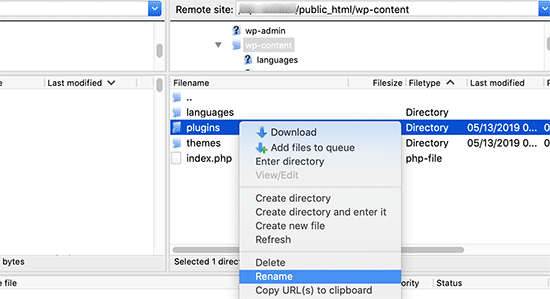
Benennen Sie einfach den Plugins-Ordner in „plugins_backup“ um. Dadurch werden alle WordPress-Plugins, die auf Ihrer Website installiert sind, deaktiviert.
Wir haben auch eine ausführliche Anleitung, wie Sie alle WordPress-Plugins deaktivieren können, wenn der WordPress-Admin nicht erreichbar ist.
Sobald Sie alle Plugins deaktiviert haben, versuchen Sie, sich bei Ihrer WordPress-Website anzumelden. Wenn Sie Erfolg haben, bedeutet dies, dass eines Ihrer Plugins das Problem verursacht hat.
Methode 5: Zum Standardthema zurückkehren
WordPress-Themes können auch nach einem Upgrade auf eine neuere Version von WordPress oder des Themes selbst Konflikte verursachen. Um herauszufinden, ob das Problem durch Ihr Theme verursacht wird, müssen Sie es deaktivieren.
Der Vorgang ist ähnlich wie bei der Deaktivierung von Plugins. Stellen Sie mit einem FTP-Client eine Verbindung zu Ihrer Website her. Gehen Sie dann zum Verzeichnis /wp-content/themes/ und benennen Sie Ihr aktuelles Theme-Verzeichnis in „themes_backup“ um.
Versuchen Sie dann, sich erneut anzumelden. Wenn Sie Erfolg haben, bedeutet dies, dass Ihr Thema das Problem verursacht hat.
Sie können nun eine neue Kopie Ihres Themes installieren, um zu sehen, ob das Problem dadurch behoben wird. Wenn das Problem erneut auftritt, müssen Sie den Support Ihres Themes kontaktieren oder zu einem anderen WordPress-Theme wechseln.
Methode 6: WordPress Core neu installieren
In seltenen Fällen kann das Problem der ständigen Aktualisierung der Anmeldeseite durch beschädigte WordPress-Kerndateien verursacht werden.
Diese Kerndateien sind die Grundlage Ihrer WordPress-Website und verwalten wichtige Funktionen. Wenn diese Dateien beschädigt oder mit falschem Code überschrieben werden, kann dies zu verschiedenen Fehlern führen, einschließlich Problemen bei der Anmeldung.
Gehen Sie zunächst zu WordPress.org und laden Sie die neueste Version der Software herunter. Nachdem Sie die Datei heruntergeladen haben, entpacken Sie sie auf Ihrem Computer. Dadurch wird ein Ordner mit dem Namen „wordpress“ erstellt, der alle erforderlichen Dateien für die Neuinstallation enthält.
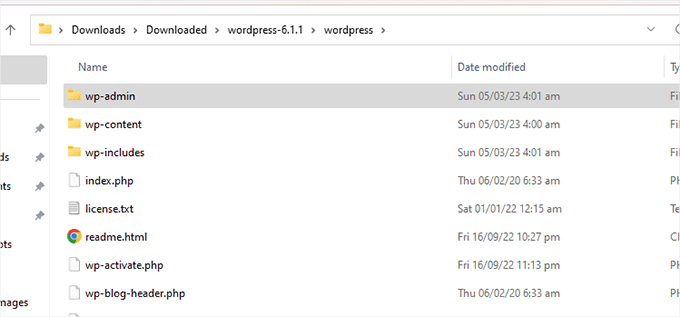
Als Nächstes müssen Sie eine Verbindung zu Ihrer Website herstellen, indem Sie einen FTP-Client oder den Dateimanager Ihres Hosts verwenden.
Sobald Sie verbunden sind, navigieren Sie zum Stammordner Ihrer Website. Dies ist das Hauptverzeichnis, das Verzeichnisse wie wp-admin, wp-content und wp-includes enthält.
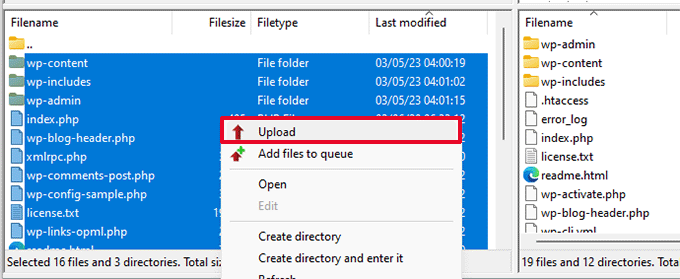
In diesem Stadium nehmen Sie alle Dateien aus dem Ordner „wordpress“ auf Ihrem Computer und laden sie in das Stammverzeichnis Ihrer Website hoch.
Ihr FTP-Client wird Sie auffordern, das Überschreiben vorhandener Kerndateien zu bestätigen.
Da Sie beschädigte WordPress-Kerndateien löschen und durch neue ersetzen, wählen Sie „Überschreiben“ und die Option „Immer diese Aktion verwenden“, damit Sie nicht jede Datei einzeln bestätigen müssen.
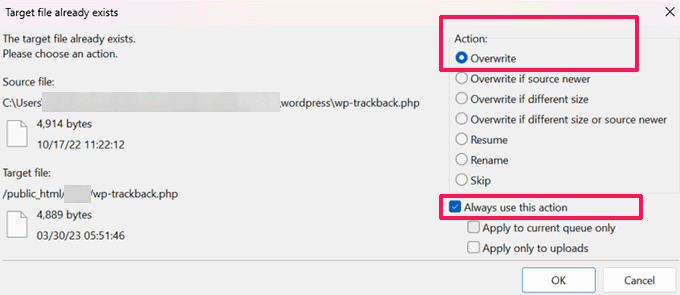
Klicken Sie abschließend auf „OK“, um den Upload-Vorgang zu starten. Ihr FTP-Client wird die WordPress-Kerndateien auf Ihrer Website durch die neuen Dateien von Ihrem Computer ersetzen.
Sobald der Upload abgeschlossen ist, besuchen Sie Ihre Website, um zu sehen, ob der Fehler behoben ist. Wenn das Problem bei der Anmeldung durch eine beschädigte Kerndatei oder Malware verursacht wurde, sollte die Fehlermeldung verschwunden sein und Sie sollten sich erfolgreich anmelden können.
Video-Anleitung
Wenn Sie eine visuelle Anleitung benötigen, sehen Sie sich bitte das folgende Video an.
Was zu tun ist, wenn Sie WordPress Login Redirect Problem nicht beheben können
Wenn Sie alles versucht haben, vom Löschen der Browser-Cookies bis zum Deaktivieren von Themes und Plugins, das Problem aber immer noch besteht, können Sie versuchen, in der WordPress-Community um Unterstützung zu bitten.
Benutzer aus Gruppen wie der WPBeginner Engage Facebook Gruppe haben vielleicht das gleiche Problem wie Sie und können Hinweise geben, was zu tun ist, um die Probleme mit der Login-Seite zu lösen.
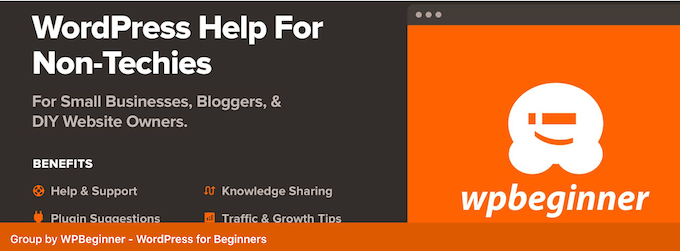
Ansonsten können Sie sich an WordPress-Support-Lösungen wie WPBeginner Pro Services wenden. Wir bieten Premium-WordPress-Support für Notfälle, bei dem Experten herausfinden können, was mit Ihrer Website passiert und die Ursache des Problems beheben.
Sie können auch unsere WordPress-Wartungsdienste in Anspruch nehmen, um zu verhindern, dass Probleme wie Malware, hohe Ausfallzeiten und veraltetes WordPress Ihre Website überhaupt beeinträchtigen.
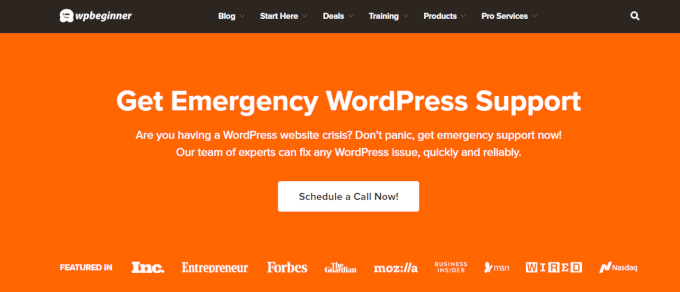
Vereinbaren Sie noch heute einen Termin mit unserem Team, um zu sehen, was wir für Ihre Website tun können.
Erfahren Sie mehr WordPress Problembehandlung Lösungen
Treten bei Ihnen andere häufige WordPress-Fehler auf und müssen Sie einen Weg finden, um sie zu beheben? Hier sind andere Artikel, die Sie sich ansehen können:
- Behebung des Fehlers „Zu viele Weiterleitungen“ in WordPress
- Wie man den Fehler „Diese Website kann nicht erreicht werden“ in WordPress einfach behebt
- So beheben Sie die Meldung „Die Website hat technische Probleme“ in WordPress
- WordPress-Beiträge mit dem Fehler 404 beheben (Schritt für Schritt)
- Wie man den Fehler „Gemischter Inhalt“ in WordPress behebt (Schritt für Schritt)
- Wie man den ungültigen JSON-Fehler in WordPress behebt (Anleitung für Anfänger)
- Wie man WordPress-Fehlerprotokolle findet und darauf zugreift (Schritt für Schritt)
- Wie WordPress nicht senden E-Mail Problem zu beheben
- Wie man WordPress im Wartungsmodus hält (Der einfache Weg)
Wir hoffen, dass dieser Artikel Ihnen geholfen hat, das Problem mit dem Aktualisieren und Weiterleiten der WordPress-Anmeldeseite zu lösen. Vielleicht möchten Sie auch unseren vollständigen WordPress-Leitfaden zur Fehlerbehebung lesen oder sich unsere Top-Tipps für die besten WordPress-Plugins und -Tools zur Erweiterung Ihrer Website ansehen.
Wenn Ihnen dieser Artikel gefallen hat, dann abonnieren Sie bitte unseren YouTube-Kanal für WordPress-Videotutorials. Sie können uns auch auf Twitter und Facebook finden.





Amnon Jakony
Deleting htaccess file worked fine for me…
WPBeginner Support
Glad to hear it was able to help you!
Admin
Harry k
Thanks for this video and the post. I tried above all of your methods but none of them fixed the issue. read the comment and found a solution as below. Edit HTTPS to HTTP.
define(‘WP_HOME’,’https://example.com’);
define(‘WP_SITEURL’,’https://example.com’);
to
define(‘WP_HOME’,’http://example.com’);
define(‘WP_SITEURL’,’http://example.com’);
WPBeginner Support
The issue with this method would be that your site would start to show the not secure message as your site would not be using HTRTPS. This can be a temporary workaround but you would want to update your site to use HTTPS after you are able to log in.
Admin
Tobias
No luck none of them worked
WPBeginner Support
If none of the methods from this article are working for you, we would recommend reaching out to your hosting provider for them to check if there are any errors on their end.
Admin
Salah
Thanks a lot,
You saved my day,
I have changed the file wp-config.php as described in the tutorial and that worked for me.
My best regards.
WPBeginner Support
Glad to hear our guide was helpful!
Admin
Robert clancy
I messed around with the Update WordPress URL Settings
and that was a world of pain to correct as it took my whole site down. I had to correct it through changing the config settings using FTP.
WPBeginner Support
The settings are definitely powerful and can cause issues if you change them incorrectly. Glad you were able to fix the issue using FTP!
Admin
DK John
Your first method worked for me. Thank you for this magical guide
WPBeginner Support
Glad our guide was helpful!
Admin
David Kuteesa
Tried all and none worked. Here is what worked:
Went to wp-config.php and set define( ‚WP_DEBUG‘, false); to define( ‚WP_DEBUG‘, true );
Tried logging in again and got „usermeta table missing“ error.
Thats when I realised I had a missing table. Got it from another installation and changed the table prefix to meet current db.
Worked immediately
WPBeginner Support
Thank you for sharing this, for most beginners we recommend reaching out to their hosting provider if our recommendations do not work as they can check for less beginner friendly errors.
Admin
Stian
Thank you – that tip about restoring the admin page by adding two lines of code in the config file seems to work nicely (still crossing fingers), but I have hope now, which I didn´t earlier.
WPBeginner Support
We hope it helps!
Admin
WPBeginner Support
Glad our guide could help and if you hadn’t set up SSL before changing to https that would definitely be the most likely cause.
Admin
branhampaul
Thank You, it worked.
I initially had the siteurl & wp address url changed to „https“, and this made me unable to log-in my dashboard. Maybe because I had not ssl at my host set-up.
Re-changing the „https“ to „http“ helped me log-in back.
Bryan Veloso
Everything didn’t work. But after downgrading my PHP from 7.4 to 7.2, I was able to login.
Kinda weird, now I’m using an older PHP version.
Did you encounter an issue similar to mine? I want to use the newer PHP version, but it doesn’t let me login in wp-admin.
WPBeginner Support
More than likely, you may have a plugin causing a conflict, you would want to start by following our troubleshooting guide below:
https://www.wpbeginner.com/beginners-guide/beginners-guide-to-troubleshooting-wordpress-errors-step-by-step/
Admin
Alisha
This issue has never happened to me before, but the 2nd / plugin option worked for me right away.
This website is a lifesaver! Thank you so much!
WPBeginner Support
Glad our guide was helpful
Admin
Øivind
Thank you! The wp-config.php-metod worked for me!
WPBeginner Support
Glad our recommendation was able to assist
Admin
Ruta
I tried some of these steps, but the problem turned out to be elsewhere: my site was setup as a ‚multisite‘ but in wp-config file it said ’subdomain_install‘ as ‚false‘, when I changed it to ‚true‘, I could login to the site normally without redirects
WPBeginner Support
Glad you found the solution to the issue
Admin
Jerry
This was also my problem! I tried all the steps mentioned in the article, but after changing the ’subdomain_install’ from false to true in the wp-config.php file it worked!!
Thanks!!
Joe
I have been trying to solve this for MONTHS… Thanks to your comment, I was able to fix it in about 10 seconds. Thank you so much for sharing!
This should be included in the tutorial.
Brayton Scott
Awesome, and simply tutorial. 1st suggestion fixed my site.
WPBeginner Support
Glad our recommendation could help
Admin
Fraser
I followed the instructions to deactivate all plugins and I now have access to wp-admin again! The instructions were easy to follow, and thanks so much for putting them out there.
WPBeginner Support
Glad our article was helpful
Admin
Sachin Baikar
Thanks for this great help. The plugin folder renaming worked for me. There was an issue with one of the plugins. Thanks once again
WPBeginner Support
Glad our recommendations were able to help
Admin
E
Thank you for this article. It is a complete lifesaver.
WPBeginner Support
Glad our guide was helpful
Admin
Philipp
I was looking for a solution for over 5 hours now – nothing worked. But deleting the htaccess file in the wp-admin directory helped!
I cant thank you enough.
Made my day.
WPBeginner Support
Glad our recommendation helped
Admin
María González
Thank you! You just saved my life (at least my job!) and a loooot of time (:
WPBeginner Support
Glad our guide was able to help
Admin
Suraj Handa
Hey but now its showing that cookies are disable in your browser please enable cookies. What can I do now?
WPBeginner Support
There are a few possible reasons for a starting point, you may want to clear your cookies and cache to be safe. For a starting point, you may want to take a look at our article below:
https://www.wpbeginner.com/beginners-guide/how-to-clear-your-cache-in-wordpress
Admin
charlie
just refresh the page, the wordpress app reacts like that because it suddenly sees no more cookies
ajay mali
you are always post great content that really helps a lot to everyone. thank you so much.
WPBeginner Support
You’re welcome
Admin
David Cuff
Very helpful. Thank you!
WPBeginner Support
You’re welcome
Admin
ibrahim zouadi
Thank you for sharing those tips, unfortunately none of them have worked for me. I even uninstalled the whole wordpress plugin. I don’t know what should i do next
WPBeginner Support
For the next step, you would want to take at our article below:
https://www.wpbeginner.com/beginners-guide/beginners-guide-to-troubleshooting-wordpress-errors-step-by-step/
Admin
Anthony
This helped like charm
Many thanks.
WPBeginner Support
You’re welcome
Admin
PDN Social
This was a lifesaver! We were able to follow step-by-step and avoid a major problem!
Great information!
WPBeginner Support
Glad our guide was helpful
Admin
Jasmeet Singh
I couldn’t find my wp admin page. It shows
„There has been a critical error on your website. Please check your site admin email inbox for instructions.
Learn more about debugging in WordPress.“
How can I fix this error?
WPBeginner Support
For that specific error, you would want to follow our guide below:
https://www.wpbeginner.com/wp-tutorials/how-to-fix-the-wordpress-white-screen-of-death
Admin
cristi
Hi, i have change by mistake my url and now the domain wp admin login url bring me to other site and i cont have ftp access how i can change back them?
WPBeginner Support
You can either reach out to your hosting provider or if you have phpMyAdmin access you could change the options table and update the URL and address.
Admin
Ankit
define(‚WP_HOME‘,’https://www.example.com‘);
define(‚WP_SITEURL‘,’https://www.example.com‘);
where do these two lines add in wp-config.php file?
At Last OR At Start?
Please clarify
WPBeginner Support
As we state in the article: paste the code just before the line that says ‘That’s all, stop editing! Happy publishing’.
Admin
Paek
Thank you so much!!!
Adding the wp-config lines solved it.
Thanks!
WPBeginner Support
You’re welcome
Admin
Ada
Thank you so much for your post. I’m a newbie with WP. These lines worked for me
define(‘WP_HOME’,’http://example.com’);
define(‘WP_SITEURL’,’http://example.com’);
I also changed the below line from false to true.
define( ‚WP_DEBUG‘, true );
WPBeginner Support
Glad our recommendation could help, the WP_Debug you should be able to return to false should you want
Admin
mojo
thank u so much after spending so much time after deleting that .htacces and restart my mac open the website finally thanks for ur time
WPBeginner Support
You’re welcome, glad our recommendations could help
Admin
Goxi
You safe my life man! Just messed around the login wp admin site if it wasn’t for this tutorial I would never have solved the problem!
WPBeginner Support
Glad our guide was helpful
Admin
Tomer
Thank you very much for this tutorial!
I have tried these methods and managed to temporarily fix the problem.
The thing is, that after everything seems to be working again, the next day it happens again. Without me changing anything at all. Any tips on that?
WPBeginner Support
You would want to reach out to your hosting provider to ensure there is nothing on their end that could be causing this conflict
Admin
Sulivan
For those who ended up here an after all steps could’t solve this, check if you changed table prefix. I have changed mines and just figured out that there are some usermeta that stores the old prefix.
WPBeginner Support
Thanks for sharing what was the issue on your site
Admin
shahin
thank you bro , amazing content and very useful
WPBeginner Support
Glad you like our content
Admin
Julie
Tks a lot ! You save me !
WPBeginner Support
You’re welcome, glad our guide could help
Admin
Ann
Thanks a lot to all of you, and specially to Hand: Changing back php version to 7.3 solved this for me!
WPBeginner Support
Glad the recommendations could help you
Admin
Hand
I had this issue and spent an entire day trying every possible solution mentioned here and elsewhere without any progress. Then I remembered that I had changed the PHP version from 7.3 to 7.4 on my hosting’s control panel (DirectAdmin). Changing back php version to 7.3 solved this for me.
WPBeginner Support
Thanks for sharing the solution that worked for you
Admin
Jeff
This worked for me.
Joe
I’ve just worked out that PHP 7.4 missed three of the extensions we had installed on PHP 7.3:
php74-php-opcache
php74-php-process
php74-php-soap
As soon as they were enabled and provisioned the wp-admin 404 error disappeared. Hope that helps you to upgrade to 7.4 trouble-free!
Shiv
Hi
I followed this article and in my case i found one plugin was causing this issue.So it found it by renaming each plugin and keep trying the login and once i reached this plugin and renamed it …admin login worked.So…i renamed back rest of the plugins to their original names and keep this once renamed and admin worked and later i sorted my plugin
Thanks
WPBeginner Support
Glad you were able to get your site working and thanks for sharing the method you used for other users with this issue
Admin
mark
I deleted the htaccess file as instructed, and now I can’t get a login screen at all. No access to my site (404)
WPBeginner Support
To check for the possible issues, you would want to go through the steps in our article here: https://www.wpbeginner.com/beginners-guide/beginners-guide-to-troubleshooting-wordpress-errors-step-by-step/
Admin
Di
Thanks, you’re a life saver. The .htaccess hack worked!
WPBeginner Support
Glad our recommendation could be helpful
Admin
gho
I owe you one! I used the codes and it’s simply worked. Big thanks wpbeginner!
WPBeginner Support
Glad our guide could help
Admin
Giang Nguyen
thanks man. Your Update Site URL works!
I tried to manually install piece by piece in my local macbook, to learn how wordpress work, and missing your piece!
The install manual doesn’t really have this kind of info =)
giang
WPBeginner Support
Glad our recommendation could help you
Admin
Todd
I’ve had this issue before many years ago and I think my fix was the same this time as it was then. After trying many many suggestions above, what finally did it for me was clearing my chrome browsing history. Someone mentioned trying that and not working, but this was not actually offered as a solution so I thought I would post it. Thanks!
WPBeginner Support
Thanks for sharing what worked for you
Admin
Peter
I was having a login error where my login page keeps refreshing and redirecting me back to the login screen. And for me (I tried all of the above solutions) and none of them worked.
Then I checked the error_log file on my WordPress site and saw that the problem I was having said „WordPress database error Disk full“
As a result, I went into my wp-config.php file and added the following code to file right above the text line where it says in the file „* That’s all, stop editing! Happy blogging. */“.
The code I added is:
define(‚WP_MEMORY_LIMIT‘, ‚256M‘);
Problem solved.
WPBeginner Support
Thanks for sharing the solution that worked for you
Admin
Chris
Thanks for this – it worked perfectly and tehe memory limit solved the problem. I was really angry because all other stuff like plugins, themes, .htaccess didn’t work!!!
Greetigs Chris
purushotham
i am not able to login my wordpress admin ,getting 404 error.what should i do to reslove the issue.
WPBeginner Support
For a starting point, you would want to reset your permalinks using: https://www.wpbeginner.com/wp-tutorials/how-to-fix-wordpress-posts-returning-404-error/
If that does not solve the error then you could try the troubleshooting steps in our guide here:
https://www.wpbeginner.com/beginners-guide/beginners-guide-to-troubleshooting-wordpress-errors-step-by-step/
Admin
Travis
None of these options worked for me… Turns out to be a hosting issue. Called Network Solutions and they said that because my database was over 300mb I needed to upgrade my database because after 300mb they lock you out…. Upgrading by DB fixed the issue. Who knew….?!
WPBeginner Support
Glad you were able to find the solution to the problem
Admin
Chris
How did you upgrade the WP database? I think this may be my problem.
WPBeginner Support
You would reach out to your hosting provider and they would let you know if you need more space for your database similar to Travis
Admin
hamdi
Defining these lines ON TOP OF wp-config.php helped. They don’t help if you put them at the bottom.
define(‚WP_HOME‘,’http://example.com‘);
define(‚WP_SITEURL‘,’http://example.com‘);
WPBeginner Support
It should still work if you place it at the bottom of the wp-config file, there may have been a problem with where you placed it depending on what’s in your specific wp-config file.
Admin
Joe G
Nothing worked for me until I went into ftp server and edited index.php in the site’s root (alongside all of the other wp-related files mentioned here), and set define( ‚WP_USE_THEMES‘, FALSE )
This will temporarily break your site temporarily (no error codes, just white screen), though my site loading wasn’t the problem. This allowed me to finally access my dashboard through the login site, where I then put a brand new theme on and fixed what I thought might be the culprit (I made the mistake of redirecting my „Home“ link on my menu to an exterior site).
After removing the „Home“ link, (or just to be safe, the menu in general), and creating a new menu with only the pages in question I wanted to use, I re-set the ‚wp_use_themes‘ to TRUE and we’re back off to the races again!
WPBeginner Support
Thanks for sharing what worked for you
Admin